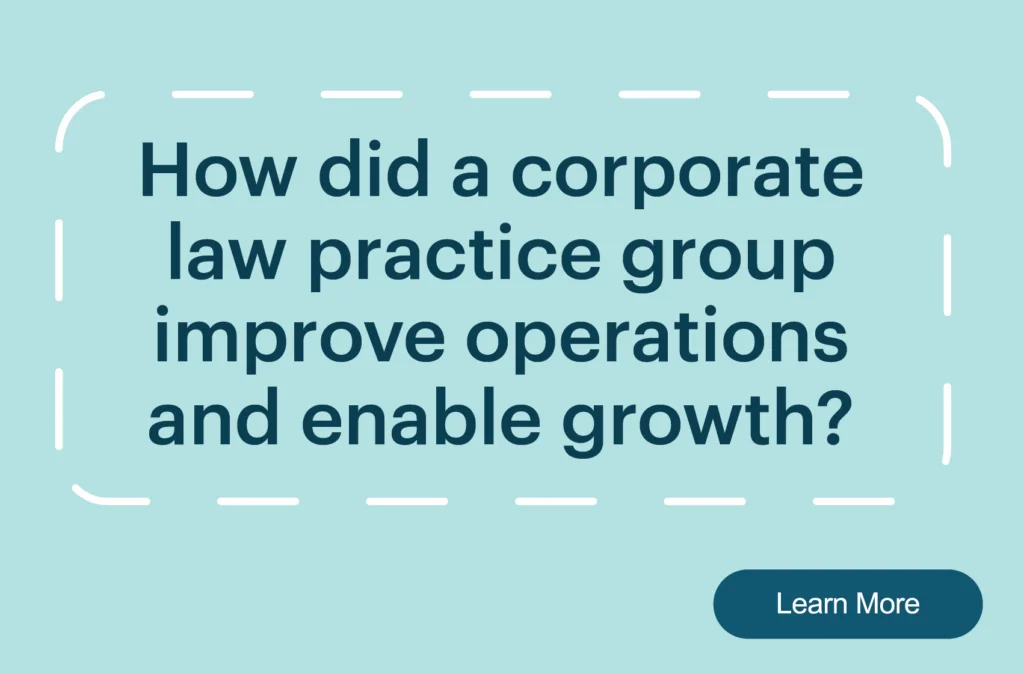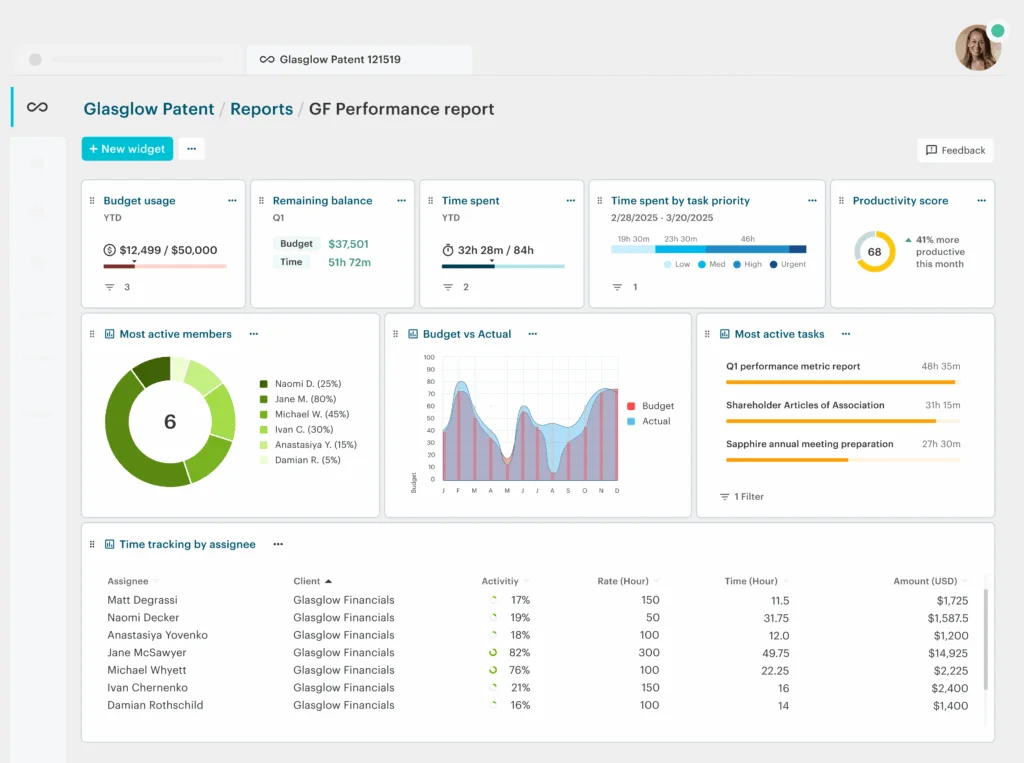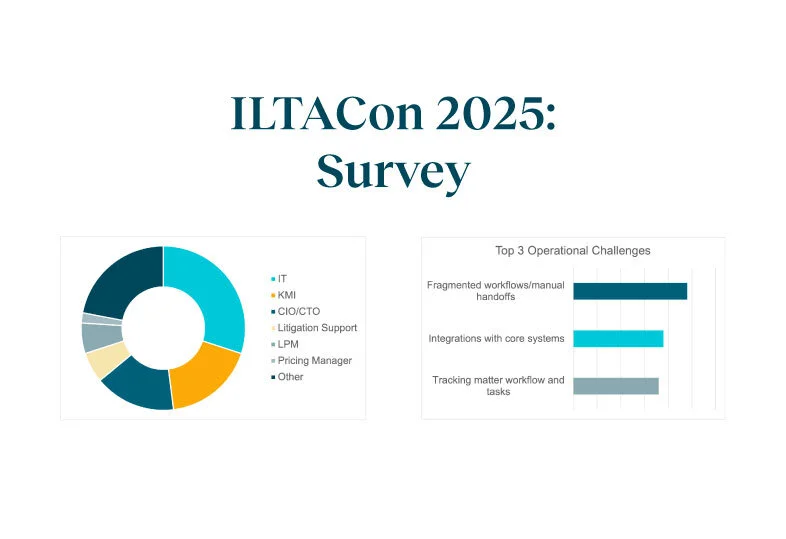Law firms are operating under increasing pressure to be efficient, transparent, and predictable, especially with the continued rise of fixed and capped fee arrangements. Clients expect timely updates, budget discipline, and consistent delivery, while internal teams need clarity on priorities, dependencies, and capacity. In this context, the matter management system becomes the operational backbone. When it falls short, the effects are felt across margins, client satisfaction, and risk exposure.
The ILTACon 2025 survey reinforces what many leaders already suspect: fragmented workflows, manual reporting, and integration gaps are widespread. Only a small minority of respondents reported “complete and sufficient” reporting. The vast majority acknowledged the need for manual consolidation to get to a single, usable view of progress and budgets. Over time, manual handoffs, spreadsheet reconciliation, and slow reporting compound into operational drag, which is eroding predictability and making it harder to manage fee structures with confidence.
This article provides a practical framework to assess whether your current matter management setup is helping or hindering using the most common symptoms identified in the ILTACon 2025 survey as guideposts.
Top 3 Reasons Your Existing Matter Management Solution Might Need an Evaluation
Reason 1: Fragmented workflows and manual handoffs
The most frequently cited challenge in the ILTACon 2025 survey was fragmented workflows. Nearly half of respondents flagged it as a core issue, with task and deadline tracking appearing as a consistent pain point across CIO/CTO, Knowledge Management and Innovation, and Project Management roles. When everyday work moves through email threads, side conversations, and/or disconnected tools, approvals stall, dependencies go unseen, and teams lose the single source of truth that keeps matters on track. The symptoms are easy to spot: status lives in multiple places, documents exist in different versions, and “who owns what” becomes a recurring question. Fragmentation also increases the likelihood of missed deadlines and inconsistent execution across similar matters.
Reason 2: Reporting requires manual consolidation
Only a small fraction of survey participants reported that their reporting is “complete and sufficient.” The majority said reporting is functional but requires manual consolidation, while a meaningful cohort described their environments as a mess with data living in spreadsheets and siloed applications. Common symptoms include exporting multiple reports to assemble a single “inclusive” view, delayed insights that arrive after a decision is needed, and inconsistent definitions of status across practice groups. This fractured approach creates friction not only for internal management, but also for client communication, where expectations around budget and progress must be consistently managed. In fee-constrained matters, lagging or incomplete data makes it harder to pivot proactively and prevent avoidable write-downs.
Reason 3: Integration gaps block visibility and scale
Integrations with core systems were highlighted as frequent challenges. IT and Knowledge Management leaders emphasized that critical data still lives in silos. The consequences are predictable: duplicative entry, mismatched matter data across systems, and difficulty connecting operational activity (tasks, milestones, utilization) to financial outcomes (budget burn, variance, realization). Without strong integration, even the best workflows don’t scale, and reporting remains labor-intensive.
Do Manual Tasks and Spreadsheet Tracking Slow You Down?
Diagnostic questions:
- How many steps in intake, routing, and approvals are still done by email or spreadsheet?
- How often do deadlines slip because task dependencies aren’t visible in a central view?
- How much time do legal project managers spend creating status updates manually?
Impact:
- Increased cycle times, more rework, and higher operational risk. A lack of central visibility reduces predictability and absorbs capacity that could be spent on higher-value work, such as risk planning or client strategy.
Desired state:
- Standardized templates for common matter types; automated routing and reminders to move work forward; and central task visibility across all matters to illuminate bottlenecks and dependencies before they become delays.
Is Your Reporting in Multiple Areas, Manual, and/or Incomplete at Times?
Diagnostic questions:
- Do you combine multiple reports to create a single view of budgets, utilization, and milestones?
- Are definitions such as “at risk” and “on track” consistent across practices?
- Do partners or clients wait for weekly or monthly summaries because the data must be manually prepared?
Impact:
- Decisions are made with lagging or partial data, internal expectations diverge from client expectations, and it becomes harder to manage fixed or capped fees with discipline. Manual consolidation also means that reporting consumes significant staff time which could be used to address emerging risks and opportunities.
Desired state:
- Live dashboards at both matter and portfolio levels, with variance alerts; role-based, one-click summaries for stakeholders; and a unified data model that eliminates the need to knit together spreadsheets for every update.
Can You Easily, Securely Communicate with Outside Vendors?
Diagnostic questions:
- Are client and vendor communications happening outside your secure environment (e.g., email or consumer tools)?
- Can deliverables and approvals be directly tied to matter tasks and documents?
- Do you maintain audit-ready records for sensitive exchanges?
Impact:
- Compliance exposure and version confusion, slower approvals, and gaps between external input and internal workflow. Sensitive information can drift outside controlled systems, and accountability becomes harder to establish.
Desired state:
- Secure, role-based collaboration spaces tied to specific matters, with controlled external access. All deliverables, approvals, and discussions live alongside tasks and documents, creating traceable records and accelerating execution.
Solution: Workstorm – Regain Operating Rhythm and Predictability
The survey’s most common pain points are precisely the areas Workstorm is designed to address. The platform builds on a secure-by-design collaboration foundation and layers in workflow automation, agentic AI, and reporting to support the way legal teams operate.
Secure-by-design collaboration foundation
- Messaging, tasks, files, and video aligned to confidentiality and governance expectations. Role-based access, audit trails, and policy-aligned controls ensure sensitive work stays within firm standards.
- External collaboration within controlled dashboards tied to matters. Vendors and clients work within defined permissions; deliverables and approvals remain traceable and connected to tasks and documents.
Workflow automation to remove manual handoffs
- Intake-to-matter templates standardize tasks, milestones, approvals, and resourcing for common matter types, which reduces re-keying and ensures consistent execution from engagement to close.
- Automated task and deadline management provides reminders, escalations, and dependency handling that keeps work moving and surfaces risks early.
- Rules-based document routing moves drafts through the appropriate review and approval paths without email coordination.
Agentic AI embedded in workflows
- Integrating your agentic AI streamlines routine, repetitive steps, such as intake validation, document triage, and task plan recommendations, and improves consistency while freeing teams for higher-value work.
- Track signals on slippage, dependency conflicts, and budget variance so teams can intervene early.
- Human-centric design keeps stakeholders in the loop: recommendations are confirmable and auditable, aligning with firms’ governance and oversight expectations.
- Performance and ROI tracking for AI agents supports responsible adoption, allowing practices to calibrate where agents add measurable value while operating under firm policies.
Reporting and real-time visibility
- Live operational reports deliver matter and portfolio visibility for milestones, utilization, budget burn, and variance and alleviate reliance on manual spreadsheet assembly.
- One-click, role-specific summaries provide clarity they need without requiring time for manual consolidation.
- Standardized metrics and templates create consistent definitions of “status,” reducing friction across practice groups and improving confidence in the numbers.
Alignment to ILTACon 2025 survey themes
- Workstorm directly addresses the top-cited issues: fragmented workflows, manual reporting, and integration gaps. The platform’s focus areas mirror where respondents see the biggest gains from automation.
- For CIOs/CTOs and IT, integrations and governance controls reduce data silos and compliance concerns. For Knowledge Management and LPM leaders, standardized templates and live reporting minimize manual effort and improve predictability. For practice leaders, role-specific views and variance alerts support fee discipline and client transparency.
Conclusion
If your current matter management environment relies heavily on manual tasks, spreadsheet-driven reporting, and workarounds to stitch systems together, it is likely limiting performance where it matters most: predictable delivery, budget control, and client trust. The ILTACon 2025 survey shows broad consensus that workflow automation and unified reporting are the most direct paths to better outcomes. The question is not whether to update, but how to do so in a way that respects firm policies, protects confidentiality, and fits into existing systems.
Workstorm offers a secure, governance-aligned approach to move from fragmented processes to standardized, automated workflows with real-time insights.
Next step: Assess your environment against the three reasons outlined above. Identify one practice area to pilot standardized workflows and live reporting within Workstorm. Use that pilot to validate impact on cycle times, variance visibility, and stakeholder satisfaction to create a repeatable model for rollout at the firm’s pace and policy. Sign up for a guided trial >



